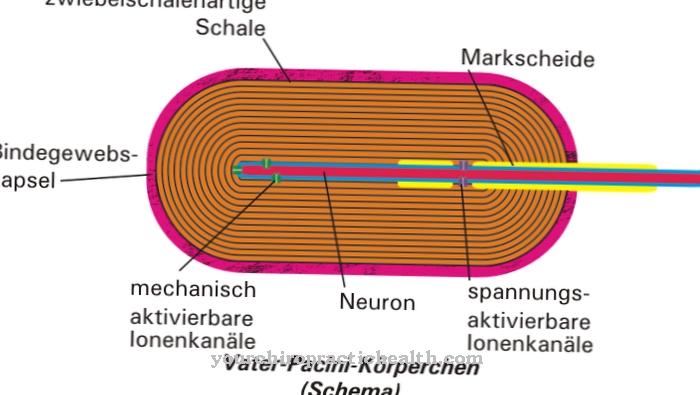The neck muscles are a very sensitive and important structure in our body. It not only enables us to perform numerous movements, but also stabilizes our spine and enables a healthy posture. An important muscle for this is the Splenius muscle.
What is the splenius muscle?
The splenius muscle is a back muscle. It belongs to the group of skeletal muscles and is part of the lateral part of the erector spinae muscle, the autochthonous muscles of the spine.
The back muscles are of great importance for the movement of the upper body. These include stretching, twisting, and tilting. In addition, it represents a permanent stabilization of the spine. The back muscles can be viewed as an active tension system, as they strengthen the spine from the head to the pelvic girdle, including the ribs. Autochthonous back muscles are deep back muscles that are supplied by the spinal nerves that lie on the back. The superficial back muscles are activated by the abdominal spinal nerves.
Autochthon translated means "originated on site". This means that muscles that were created here have not migrated. The non-autochthonous muscles have grown towards the back as an embryo over the course of human development and lie on the autochthonous muscles, i.e. superficially.
Anatomy & structure
The autochthonous muscles are divided into three sections. The structure is based on the nerve supply from the spinal nerve. The posterior branch, also called the posterior branch, of the spinal nerve supplies the back muscles, which are divided into two tracts: the medial tract is supplied by the medial branch of the posterior branch and the lateral one by the lateral branch of the posterior branch. The splenius muscle belongs to the lateral tract of the autochthonous back muscles.
The lateral tract lies between the transverse processes and the rib angle, also called the angulus costae. In addition to the attachment points to the transverse and spinous processes of the spine and the rib sections, the muscles also attach to the skull or coccyx, the os sacrum. The most efficient muscle is the extensor muscle longissimus. The plenius muscle consists of two parts, the splenius capitis muscle and the splenius cervicis muscle.
The splenius capitis muscle has its origin close to the head at the spinal spinous process (processus spinosi) of the 3rd-7th centuries. Cervical vertebra, as well as the 1st-3rd Thoracic vertebra. Another important point is the ligamentum nuchae, the neck ligament. Its insertion is on the upper neck line (Linea nuchae superior).
The spleniius cervicis muscle has its origin a little deeper on the spinal spinal process of the 3rd-5th Thoracic vertebra, as well as on the temporal bone (Proccesus Mastoideus) and the occiput (Os occipitale) and attaches to the posterior cusp (Tubercula posterior) of the bone process of the cervical vertebrae 1-3.
The general function of the autochthonous back muscles is dorsiflexion or trunk straightening. They take on this function because they lie dorsal to the transverse flexion and extension axes (flexion and extension axes).
Function & tasks
The function of the splenius muscle is a dorsiflexion, i.e. an inclination of the back of the head, by contraction of the muscle on both sides. This will also result in head reclination, i.e. Extension of the cervical spine, called.
In addition, a unilateral contraction enables rotation and lateral inclination of the head and the cervical spine to the same side. The splenius muscle with the other autochthonous muscles in the cervical and thoracic spine enables us to move as far as possible in all directions.
You can find your medication here
➔ Medicines for back painDiseases
The muscles of the cervical and thoracic spine are very sensitive to stress and cause headache and neck pain in many patients. Permanent incorrect posture or movement can lead to tension. These restrict the head in its movement and mainly cause local tenderness and pain. This manifests itself in neck pain. Since the muscles are constantly tense to stabilize our head and spine, the pain persists even at rest. The result can be a stiff neck.
Such illnesses are often found in office workers, which is why there is also the term: "Word Processor Headache". In addition, the muscle is often affected by sudden contractions, e.g. in trauma from a car accident, severely irritable. Another risk factor for muscle irritation are cold drafts, such as by air conditioning or while riding a motorcycle. In addition to the stiff neck, the tension can also cause a deterioration in vision.
It is important to note that breathing can also cause pain. Chest pain, or rather rib pain, is mainly caused by tension in the neck and thoracic spine. The cause is the close anatomical connection between the muscles and the bones. Tension in the cervical spine and / or the thoracic spine tensions the mobility of the ribs. The result is a drawing pain in the chest and shallow breathing.
Once the tension is there, it rarely resolves on its own. In addition to physical therapy prescribed by the doctor, you can do some exercises for your neck yourself. The possible exercises for your neck muscles are very similar to the normal movement options for your neck muscles.
1. Slowly let your head fall back. Now slowly circle your head up to the initial situation. You can do this several times a day to stretch your muscles.
2. Tilt your head to the left. Your right arm will hang next to your hip. With your left hand, you can increase the stretch if necessary by gently adding some pressure. Remain in this position for 20 seconds, breathing deeply and repeat the exercise for the right side. If you do not feel any improvement or even worse, it is advisable to consult a doctor.
























.jpg)



